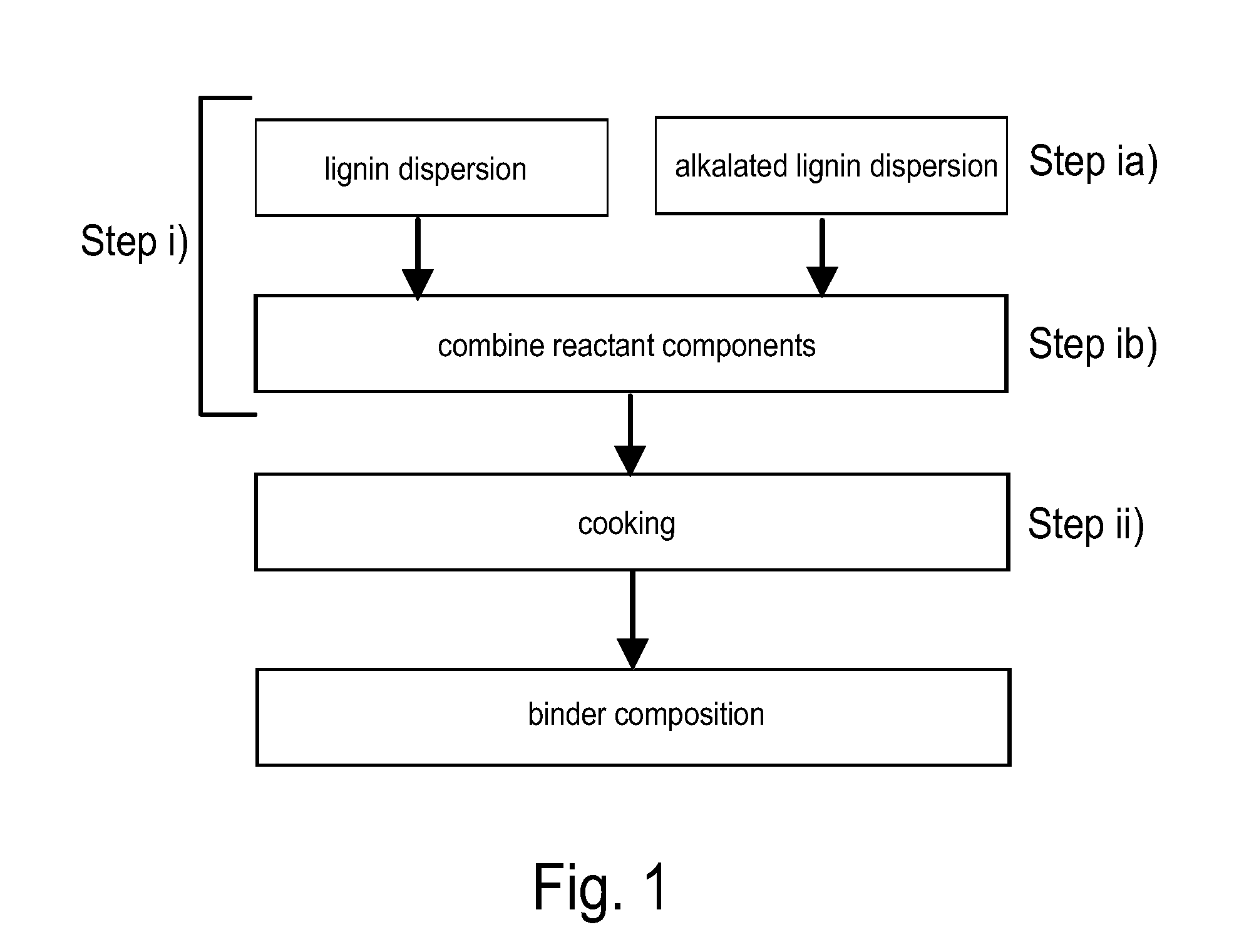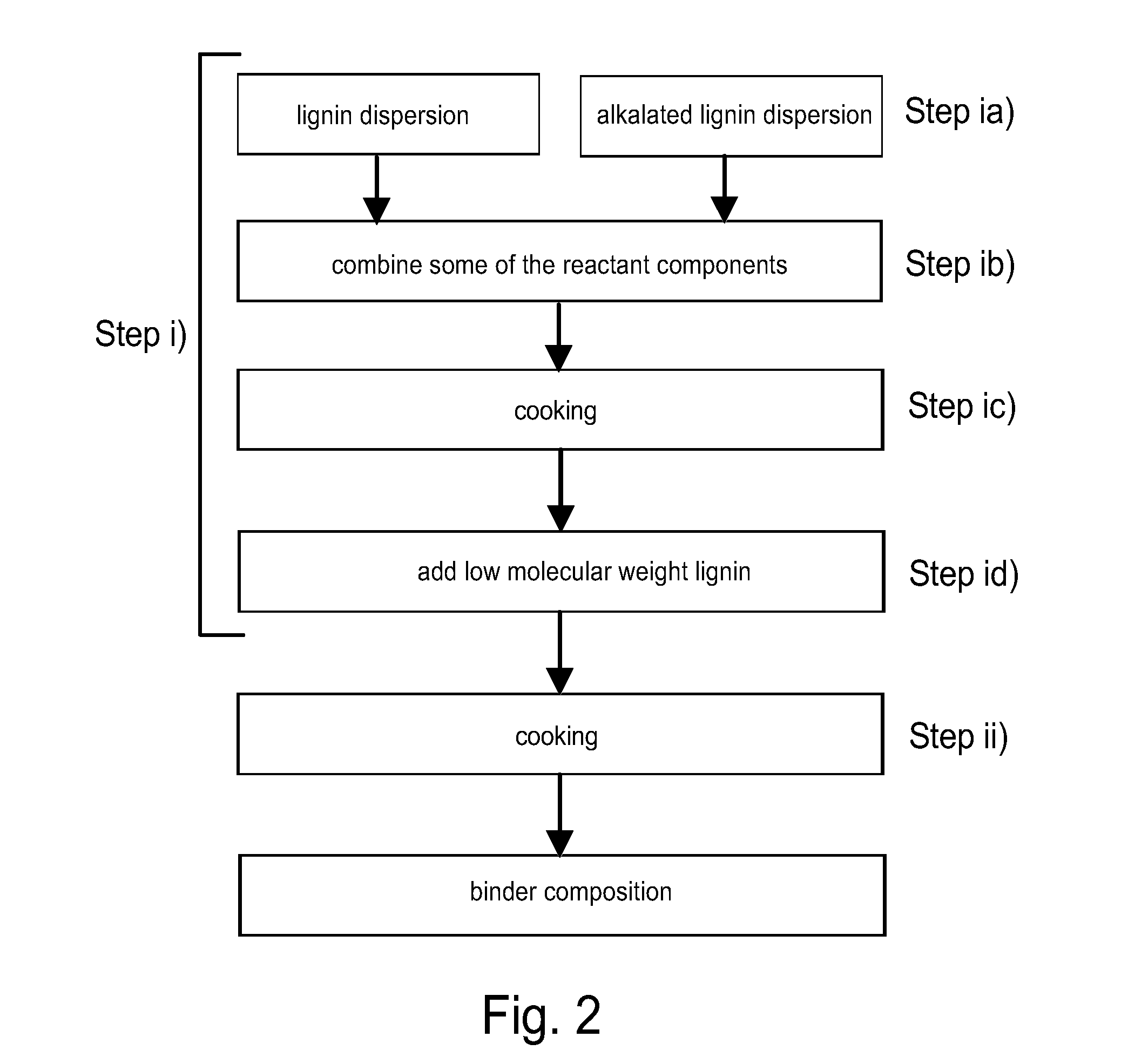Use of low molecular weight lignin together with lignin for the production of a phenol-formaldehyde binder composition
a technology of phenol-formaldehyde and lignin, which is applied in the direction of lignin adhesives, adhesive types, layered products, etc., can solve the problems of unsatisfactory properties of produced glues, and achieve the effect of a higher level of bio-based components
- Summary
- Abstract
- Description
- Claims
- Application Information
AI Technical Summary
Benefits of technology
Problems solved by technology
Method used
Image
Examples
example 1
Preparing a Binder Composition
[0099]In this example a binder composition was produced. The following components and their amounts were used:
concentrationamount (g)water352NaOH-I50%181HMW-lignin98%100LMW-lignin98%200phenol90%327formaldehyde40%608NaOH-II50%90
[0100]Firstly, water, the first part of NaOH (NaOH-I) and high molecular weight lignin (HMW-lignin), i.e. lignin having an average molecular weight of 7000 g / mol. were mixed such that a dispersion was formed. Simultaneously the temperature increased from room temperature to about 60° C. Then part of the low molecular weight lignin (LMW-lignin), i.e. lignin having an average molecular weight of 1700 g / mol, was added to the dispersion while keeping the temperature at 25-50° C.
[0101]Then all of the phenol was added followed by adding the formaldehyde in a stepwise manner for forming an aqueous composition. The temperature was kept under 75° C. After adding the formaldehyde the composition was allowed to react for 10 minutes after whi...
example 2
Preparing a Binder Composition
[0104]In this example a binder composition was produced. The following components and their amounts were used:
concentrationamount (g)water578NaOH-I50%254HMW-lignin61%492LMW-lignin90%111phenol90%443formaldehyde-I40%448formaldehyde-493IINaOH-II50%127
[0105]Firstly, water and the first part of NaOH (NaOH-I) were mixed and heated up to a temperature of 75° C. Then the HMW-lignin, i.e. lignin having an average molecular weight of 3000 g / mol, was added followed by the addition of LMW-lignin, i.e. lignin having an average molecular weight of 1300 g / mol. When also the LMW-lignin had been added to the dispersion, the dispersion was heated at a temperature of 75° C. for about one hour in order to form alkalated lignin.
[0106]After the dispersion had been cooled down to ° C. the phenol was added followed by adding the first part of the formaldehyde (formaldehyde-I) in a stepwise manner for forming the aqueous composition. Then the temperature was increased up to 75°...
example 3
Preparing a Binder Composition
[0108]In this example a binder composition was produced. The following components and their amounts were used:
concentrationamount (g)water179NaOH-I50%102HMW-lignin97%146LMW-lignin97%72phenol90%123formaldehyde40%370NaOH-II50%51
[0109]Firstly, water, the first part of NaOH (NaOH-I) and HMW-lignin, i.e. lignin having an average molecular weight of 8000 g / mol, were mixed under heating such that a dispersion was formed. Then the temperature was adjusted to 50° C., the phenol was added and then the formaldehyde was added in a stepwise manner during a period of one hour. The temperature was kept under 75° C. After the formaldehyde had been added the second part of the NaOH (NaOH-II) was added. After the addition of NaOH-II, the composition was cooked at 75° C. until the viscosity of the composition was 100 cP. Then the LMW-lignin, i.e. lignin having an average molecular weight of 350 g / mol, was added to the composition. The cooking was continued at the temperat...
PUM
| Property | Measurement | Unit |
|---|---|---|
| weight ratio | aaaaa | aaaaa |
| weight ratio | aaaaa | aaaaa |
| temperature | aaaaa | aaaaa |
Abstract
Description
Claims
Application Information
 Login to View More
Login to View More - R&D
- Intellectual Property
- Life Sciences
- Materials
- Tech Scout
- Unparalleled Data Quality
- Higher Quality Content
- 60% Fewer Hallucinations
Browse by: Latest US Patents, China's latest patents, Technical Efficacy Thesaurus, Application Domain, Technology Topic, Popular Technical Reports.
© 2025 PatSnap. All rights reserved.Legal|Privacy policy|Modern Slavery Act Transparency Statement|Sitemap|About US| Contact US: help@patsnap.com


